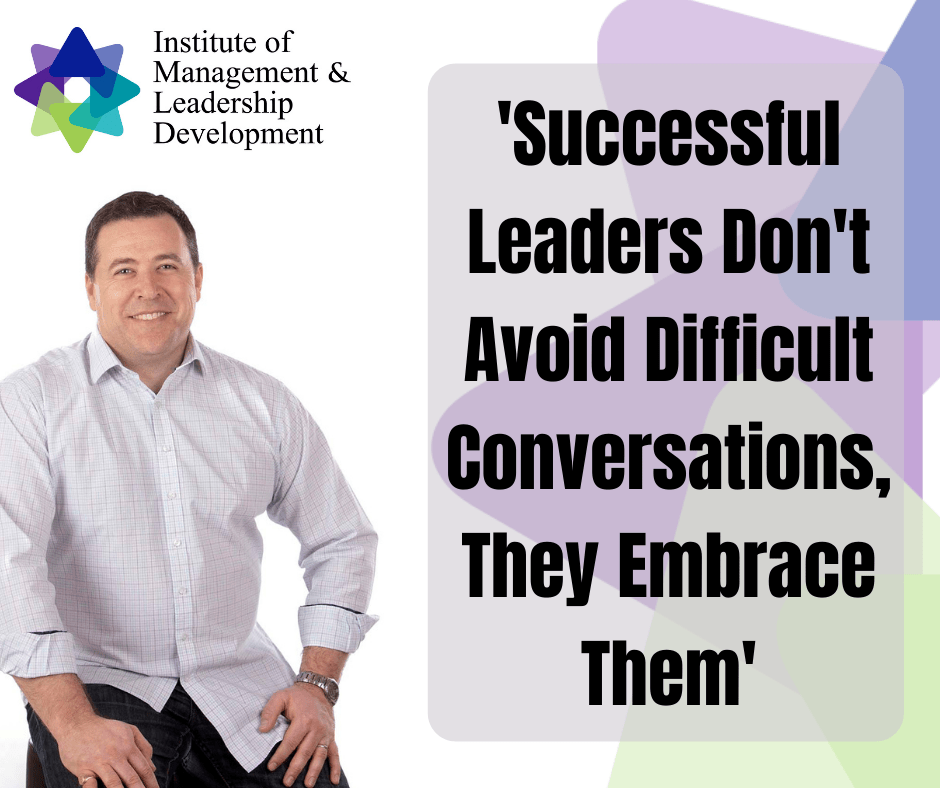Successful leaders don’t avoid difficult conversations, they embrace them as opportunities. (and Yes, they are still uncomfortable)
How to have a difficult conversation at work
Difficult conversations — whether you are telling an underperforming an team member that they need to do to improve on something, or advising your boss of a missed deadline — are part and parcel of being a leader, manager or supervisor. What is the best way to prepare for this type of conversation? What should you say (or not say)? How do you find the right words in the moment and be able to respond in an appropriate way if the person doesn’t agree or acknowledge what you have raised? And, how can you manage the ‘back and forth’ of the conversation so that it goes smoothly and you get the outcome you want?
Being in conflict can feel uncomfortable for a large number of reasons; fear, lack of a clear outcome, lack of practice, getting carried away with emotions etc.
It is very easy to not deal with little things such as misunderstandings, slights, and miscommunications, resulting in relationships ‘drifting’ from where you would like them to be. If these little things are addressed, the difficulty in raising them can be small, along with the repercussions. If these misunderstandings are allowed to fester, as well as be added to through further conflict, these issues can become much bigger – and the consequences can be harder to address.
No leader likes having difficult conversations – but successful leaders understand the necessity (for themselves, the business and the team member) and they push through the difficulty to have them anyway.
DRIFT Conversations – A Template For Difficult Conversations
Preparing a DRIFT conversation is a simple way of stating what you would like in a conflict situation with another person without making personal attacks and judgements on the other person’s character. It is a way of stating what is required and what is needed, and bring things more in alignment.
DRIFT describes the difference between where we would like a relationship / discussion to be, and where we have ended up – we have ‘drifted’ away from what we want. A DRIFT conversation is a way of assertively bringing the relationship ‘back on track’ through a planned and thoughtful conversation.
D – Describe / Define
Describe the situation and the circumstances that have made you want to have a discussion. The focus on the description should be facts, facts and facts. Describe what has happened in data only with information that cannot be disputed.
One of the biggest mistakes people make in having a difficult discussion is in ‘judging’ a behaviour rather than describing it.
Right:
‘On three separate occasions this week you have been more than 30 minutes late to work’
Wrong:
‘It is really unprofessional how you have turned up late to work this week’
Judgements from the person raising a difficult conversation push the person receiving the conversation into ‘fight or flight’ mode. The person will either push back on what you have said, argue or nitpick the small points of what you say. Conversely, the person will shut down, agree with everything or not listen to what you have raised. Either response ensures that the difficult conversation will not hit its mark.
One thing you can do to reduce the need for DRIFT conversations is be very clear with the people around you regarding what you like and what do you don’t. For help establishing this, have a look at the article ‘Is Your Team Flying Blind to Your Expectations?’ and download the Team Expectations Checklist.
R – Results / Repercussions
Stephen Covey in ‘The 7 Habits of Highly Effective People’ says that we should begin ‘with the end in mind’. The same applies with a difficult conversation – what is it you want to achieve by having the conversation? What is the resulting behaviour you would like to take place? What will be the repercussions if things change or stay the same? When you think of the repercussions or consequences, consider the following:
What will happen if the person doesn’t change their behaviour? What will you do? How you will react? What future measures will you put in place?
What will happen if the person does change their behaviour? What will you say? How will you reinforce the behaviour further?
Knowing the negative and / or positive consequences can provide motivation to change a behaviour or pattern of behaviour
I – Inoculation
In 1796, Dr Edward Jenner discovered how to inoculate children against the the disease smallpox. The premise was to use a small amount of the dead virus and inject it into the patient, providing the body an opportunity to develop antibodies and fight the disease. When the patient would next be exposed to smallpox, they already had the means within the body to fight the disease.
We seek to do the same for people we want to have a difficult conversation with. ‘Inoculating’ a person for difficult conversation provides them with the time and space to be able to process the conversation that will take place, reducing the usual ‘fight of flight’ response.
Inoculating someone for a conversation affords them the respect of having time to adjust to the conversation and prepare for what will take place. The inoculation also allow you, the person initiating the conversation, time to think regarding how you would like to approach the situation.
Right:
‘I would like to talk with you regarding arrival at work this week. Can we discuss it 10am?’
‘There were some details in the report you wrote that I am not happy with and needs improvement. Can we discuss them after lunch?’
Wrong:
‘It is really unprofessional how you have turned up late to work this week’
‘You really could have done a better job on that report. We need to talk about it’
Keys components of a good inoculation:
- It isn’t personal and does not attack them
- It gives a brief outline of the conversation to take place
- It matches the feeling you have on the topic
- It provides the person with the opportunity to agree and respond
F – Feeling
How do you feel about the situation you are raising?
Describing the emotion that you feel is a critical part of the difficult conversation process. They say that ‘No one has the power to take away how you feel’ and one it comes to difficult conversations, it couldn’t be more true. It is important to discuss how you feel about the issue to wish to raise, not how you feel about the person you are speaking to. This distinction can make all the difference when having the conversation.
Right:
Describe how you feel about the issue and its impact
Wrong:
Describe how you feel about the person and pass judgement on them
Being clear on how you feel makes it easier for the person receiving the information to understand its impact on you, and makes them more likely to adjust their behaviour. That said, a large number of people struggle to work out how they actually feel on an issue. Are you anxious, annoyed, embarrassed, overwhelmed, hurt, worried or resentful? Are you happy, relieved, elated or excited?
While it might take some effort to reflect and consider how the situation makes you feel, it makes all of the difference. Whether you know it or not, your body language, tone and demeanour is going to reflect how you feel, and clearly stating it will have all of your communication (verbal and non-verbal) reflect it. Saying you feel one thing (or saying nothing at all), when your body language reflects something else leaves the person you are speaking to confused or worse, lied to.
Timing & Specifics
This is the part of the difficult conversation where you discuss what it is you would like to change in the future. Many people that have a difficult conversation don’t provide the clarity of what they want or what they would like to change, leaving it up to the person receiving the information to work it out for themselves. This rarely provides the solution that you want. Be clear on what you would like and when you would like it to happen.
How do you want the situation to change?
How do you want the behaviour to be altered or changed?
What do you want the person to start doing or stop doing?
What standard do you expect the behaviour to be at in the future?
How often do you want it to happen in the future?
Being explicitly clear about what you want to happen in the future is important to getting what you want to happen in the future. It might sound simple, but if you can’t describe what you want to change in the future, how will the person you are speaking to know what you want?
DRIFT Plan not DRIFT Script
Writing a DRIFT plan provides you with the opportunity to clarify your thoughts, get specific with your emotions and provide people with feedback that can make a difference. Remember – it is a plan, not a script. A conversation is a two-way thing, and you have only prepared and thought out one side of the conversation. At each stage of the DRIFT conversation, there is an opportunity to ask questions, clarify and discuss from both parties.
The DRIFT Plan is about know your key points – it isn’t a carefully worded script that must be delivered line by line. The person you are talking to doesn’t ‘know their lines’, making a carefully written script useless. In addition, delivering a full script to someone without interruption is now a statement (or an accusation), not a discussion.
Practice and Reflect Difficult Conversations
Like most activities, the more you have difficult conversations, the better you get at them. It is much easier to start with the small drifts and deviations from what you want, rather than tackling a large performance management issue that has been avoided for years. Don’t avoid the big, important conversations – but remember to walk before you run.
When you have the ability to provide effective constructive and positive feedback, you have the ability to ensure the people around you can perform at their best – a key function of any leader.
Looking for Help to Prepare, Plan, Deliver or Practice a Difficult Conversation?
Our ‘Difficult Conversations in the Workplace’ workshop is the place to start! If it is in a more formal setting you need need, check out the ‘Performance Management Essentials‘ workshop. Both workshops provide the knowledge, guidance, expertise, tips, tricks and practice to have a difficult conversation made easier.
Related Articles On Difficult Conversations
Practice Builds Confidence With Difficult Conversations
Does Any Leaders Like Having A Difficult Conversation?
Leadership 101: Looking to Avoid Difficult Conversations? Have More Smaller Ones



